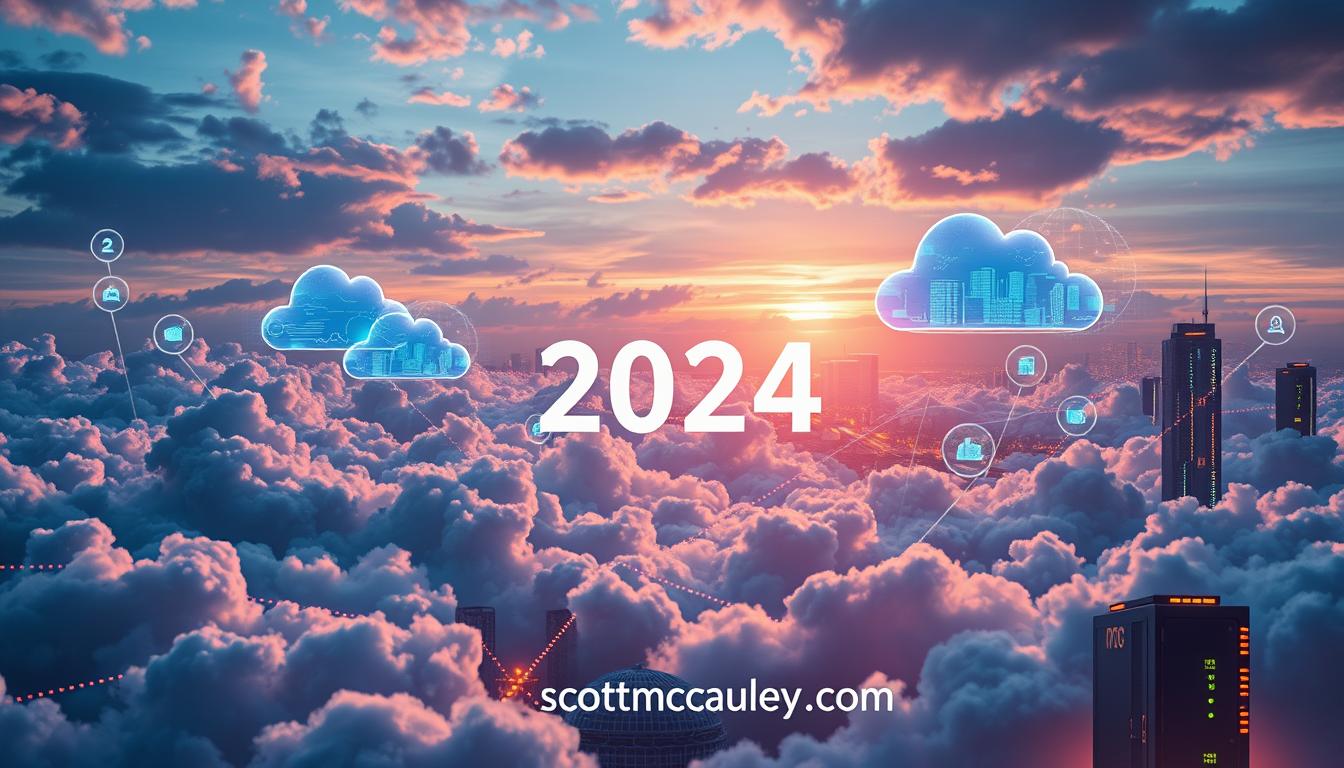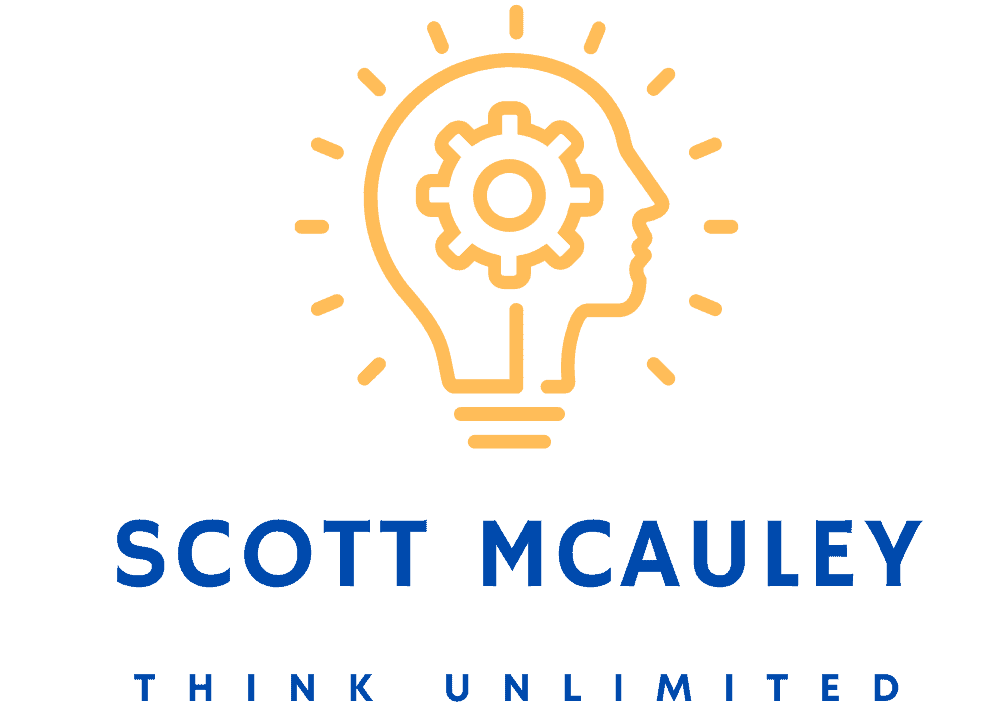A recent MSys survey of 400 tech pros reveals exciting news. The cloud computing market could hit USD 1 trillion by 2028. This growth shows how vital cloud tech is for business success.
Cloud tech’s future is bright with new trends emerging. AI integration, sustainable computing, and serverless setups are leading the way. These changes will transform how companies work and compete.
Businesses that embrace these trends will thrive. They’ll be ready to tap into cloud computing’s vast potential. The market’s expected growth offers huge opportunities for forward-thinking firms.
Staying up-to-date on cloud computing is key for businesses in 2024. Knowing the latest trends helps companies make smart tech choices. These trends point to an exciting future in cloud computing.
Key Takeaways
- Cloud computing market is projected to exceed USD 1 trillion by 2028
- AI integration, sustainable practices, and serverless architectures are driving innovation
- Businesses must stay informed about the latest cloud trends to remain competitive
- Embracing cloud technologies is crucial for successful digital transformation
- The top five cloud computing trends for 2024 offer exciting opportunities for growth and innovation
Introduction to Cloud Computing Trends
Staying updated with cloud trends is vital for business success. Cloud computing is evolving rapidly, offering new opportunities for flexibility and scalability. The 2024 outlook shows promising developments that will shape cloud technology’s future.
Importance of Staying Updated
Keeping up with cloud trends helps businesses make smart choices. Global cloud spending is set to hit $679 billion by 2024. Most companies now use public and private cloud solutions.
Cloud adoption is no longer optional. It’s a must for success in today’s digital world.
Overview of Cloud Technology
Cloud tech offers various services and deployment models. In 2024, more businesses will adopt multi-cloud strategies for flexibility and risk reduction.
Edge computing is set to change data processing. It brings computation closer to the source, improving speed and performance.
Major cloud providers are investing in AI and machine learning. These advancements will streamline operations and cut costs for businesses.
Trend 1: Increased Adoption of Multi-Cloud Strategies
Businesses are increasingly adopting multi-cloud and hybrid cloud solutions. By 2024, Bay Area enterprises are expected to increase multi-cloud strategy adoption by 25%. This growth stems from the need for flexibility and reduced vendor dependency.
Flexera’s 2024 “State of the Cloud” survey reveals promising data. 97% of IT respondents plan to adopt multi-cloud systems within a year. Small organizations have seen 21% profit increases and 26% growth using multi-cloud strategies.
Benefits of Multi-Cloud Approaches
Multi-cloud adoption offers numerous advantages for businesses. These include increased agility, cost optimization, and risk mitigation. Companies can choose the best solutions for their needs, avoiding vendor lock-in.
Finance executives report significant gains with multi-cloud strategies. Revenue increases of up to 15% and profitability boosts of up to 4% have been observed.
| Benefit | Percentage |
|---|---|
| Reduced time to market | 65% |
| Reduced startup costs | 94% |
Challenges Facing Multi-Cloud Implementation
Implementing multi-cloud strategies isn’t without challenges. Data portability, security, and management complexity are major concerns for businesses. Careful planning is crucial for seamless integration between multiple cloud providers.
Over 90% of organizations now use some cloud environment, and by 2024, 86% of companies expect to migrate to a multi-cloud system.
The trend towards multi-cloud adoption continues to grow rapidly. The global cloud computing market is projected to reach $2.29 trillion by 2032. This represents a compound annual growth rate (CAGR) of 16.5%.
Trend 2: Growth of Edge Computing
Edge computing is set to grow rapidly across industries by 2024. This approach brings data processing closer to sources. It offers many benefits for businesses aiming to improve operations.
Connected devices will reach 17.08 billion by 2024, up from 15.14 billion in 2023. This growth will drive edge computing adoption. IDC predicts 157 zettabytes of data generated in 2024, with 20% at the edge.
What is Edge Computing?
Edge computing processes data near its source, like IoT devices or local servers. This reduces latency and improves data privacy. It enhances scalability for data-heavy applications.
Edge computing is crucial for real-time decision-making. It’s used in autonomous vehicles, industrial automation, and remote monitoring.
Key Advantages for Businesses
Edge computing offers several benefits for businesses:
- Reduced Latency: Processing data closer to the source enables faster response times and better user experiences.
- Enhanced Data Privacy: Local data processing reduces breach risks and ensures compliance with privacy regulations.
- Scalability for IoT Applications: Edge computing handles vast amounts of IoT data, easing the load on central cloud infrastructure.
- Real-Time Data Processing: It enables quick decision-making based on up-to-date information from various sources.
5G networks will boost edge computing growth. They offer high bandwidth, low latency, and increased connectivity. These features are ideal for edge computing applications.
5G connections are expected to reach 2 billion by late 2023. They may hit 8 billion by 2026, outpacing LTE growth.
Trend 3: Enhanced Focus on Cloud Security
Cloud security is now a top priority for businesses. 93% of organizations worry about cloud security. Cyber threats targeting cloud environments are becoming more frequent and sophisticated.
This heightened focus stems from increasing cyber attacks. Organizations must take proactive measures to protect their cloud-based operations and data.

Key Security Concerns in 2024
Data breaches are the biggest threat, affecting 18.7% of surveyed organizations. The average cost of a data breach is $3.92 million.
Misconfigured cloud services pose another serious risk. 66% of organizations have faced attempts to exploit these vulnerabilities.
Rapid cloud adoption makes proper configuration crucial. Access controls must be implemented to reduce security risks.
Solutions to Address Security Risks
Organizations need comprehensive data protection strategies. Robust security protocols, like homomorphic encryption, are essential. This method allows computations on encrypted data.
Regular security audits help identify vulnerabilities. They also ensure compliance with industry standards. Partnering with reputable cloud providers is crucial for security.
84% of enterprises use multiple cloud platforms. This requires a unified security approach. The Cybersecurity Mesh Architecture offers scalable, flexible security controls.
It addresses challenges in multi-cloud environments. This approach distributes security measures across different platforms. It’s an effective solution for complex cloud setups.
Trend 4: Rising Popularity of AI-Driven Cloud Services
AI in cloud services is growing rapidly. The global AI market may reach $1,339 billion by 2030. Cloud infrastructure makes AI benefits accessible to all enterprises.
AI-as-a-Service lets businesses use machine learning without extensive in-house expertise. This could boost the US GDP by 21% by 2030. Companies can enhance productivity and drive innovation with AI.
AI’s Role in Cloud Optimization
AI optimizes cloud environments, maximizing efficiency and minimizing costs. It allocates resources, monitors performance, and predicts issues proactively. This approach ensures seamless scaling while maintaining optimal performance.
64% of businesses believe AI will boost productivity. 72% have adopted AI for at least one function. AI-as-a-Service solutions are expected to grow 36.6% annually from 2023 to 2030.
Use Cases of AI in Cloud Computing
AI in cloud computing spans various industries. It unlocks new levels of efficiency, personalization, and innovation. Here are some notable use cases:
- Personalized customer experiences: AI-powered analytics can analyze vast amounts of customer data to deliver targeted recommendations, personalized content, and tailored services.
- Fraud detection and security: Machine learning algorithms can identify patterns and anomalies in real-time, helping businesses detect and prevent fraudulent activities and enhance overall security.
- Supply chain optimization: AI can streamline supply chain processes, predicting demand, optimizing inventory levels, and identifying potential disruptions before they occur.
Healthcare and automotive industries will see significant AI impact. AI can analyze complex medical data and assist in diagnostics. It can also power self-driving vehicles, revolutionizing transportation.
Trend 5: Serverless Computing Gains Traction
Serverless computing is growing as a cost-efficient solution for businesses. It allows organizations to focus on code without managing infrastructure. This shift promises faster deployment, improved cloud scalability, and reduced costs.
Definition and Benefits of Serverless Models
In serverless models, developers write and deploy code as functions. These functions are triggered by events or requests. The cloud provider then allocates resources to execute them.
Serverless computing offers several key benefits. These include reduced operational costs and pay-per-use pricing. It also provides automatic scaling and increased developer productivity.
- Reduced operational costs, with a significant percentage reduction compared to traditional infrastructure
- Pay-per-use pricing, where users are charged only for the compute time consumed during function execution
- Automatic scaling based on demand, ensuring optimal resource utilization
- Substantial increase in developer productivity, as they can focus on writing code rather than managing servers
“Serverless computing is a game-changer for businesses looking to optimize their cloud infrastructure and reduce costs.” – Jane Smith, Cloud Architect
Major Platforms Supporting Serverless
Leading cloud providers now offer robust platforms for serverless application development. These platforms support various programming languages and integrate with cloud services.
| Platform | Provider | Key Features |
|---|---|---|
| AWS Lambda | Amazon Web Services | Supports multiple languages, integrates with various AWS services |
| Azure Functions | Microsoft Azure | Seamless integration with Azure services, support for multiple languages |
| Google Cloud Functions | Google Cloud Platform | Easy deployment, automatic scaling, integration with GCP services |
A CNCF survey shows 58% of respondents use serverless computing for some applications. The serverless market is expected to reach $14 billion by 2025.
This growth shows a 24% CAGR. As adoption rises, businesses can expect improved efficiency, scalability, and cost savings in cloud deployments.
Key Technologies Influencing Cloud Trends
Cloud computing is constantly evolving, driven by emerging technologies. These innovations enhance cloud platforms and create new opportunities for businesses across various sectors.
Quantum Computing
Quantum computing in the cloud is an exciting recent development. It has immense potential for solving complex problems and accelerating scientific discoveries. Major cloud providers are investing heavily in quantum computing research.
They offer quantum-as-a-service platforms to customers for experimenting with quantum algorithms. This allows businesses to explore potential uses without expensive hardware investments. Quantum computing is set to revolutionize cryptography, optimization, and machine learning.
Internet of Things (IoT)
The Internet of Things (IoT) is another key driver of cloud computing trends. Connected devices generate vast amounts of data. IoT cloud solutions manage and analyze this data, enabling valuable insights.
Cloud platforms offer scalable solutions for IoT data storage and processing. They provide secure connectivity and device management for smooth IoT ecosystem operation. Cloud providers are investing in IoT-specific services to help businesses leverage connected devices.
“The combination of IoT and cloud computing is a game-changer for businesses. It enables them to collect, process, and analyze massive amounts of data in real-time, unlocking new opportunities for innovation and growth.” – Industry Expert
Other technologies are also shaping the cloud landscape. Blockchain integration provides secure solutions for data sharing and transactions. Augmented reality (AR) and virtual reality (VR) use cloud infrastructure for immersive experiences.
Cloud gaming innovation is transforming the industry, offering high-quality games without powerful hardware. These evolving technologies drive cloud computing advancements, creating new possibilities for businesses in the digital era.
Impact of Regulatory Changes on Cloud Computing
Businesses face complex regulatory changes in cloud computing. In 2024, these regulations will significantly impact cloud strategies. Cloud computing regulations, data privacy laws, GDPR compliance, and industry-specific standards will shape cloud adoption.

Major legislation like GDPR has set stricter data privacy measures. Healthcare, finance, and telecom sectors face stringent regulations. Non-compliance can lead to fines, reputation damage, and legal consequences.
Evolving Regulatory Landscape
The regulatory landscape demands constant vigilance from businesses. New regulations emerge rapidly, requiring strategy adjustments. Non-compliance can result in severe penalties.
Compliance Challenges for Businesses
Ensuring compliance across jurisdictions is challenging for businesses. Data breaches can trigger non-compliance, leading to severe repercussions. Companies must adopt robust measures and work with compliance-focused cloud providers.
Healthcare organizations face unique challenges with cloud computing integration. HIPAA mandates strict data privacy for patient information. Specialized solutions are needed to avoid non-compliance in healthcare cloud services.
“By adopting compliance regulations, organizations can lay a strong security foundation against data breaches, protecting sensitive information from unauthorized access and reducing the likelihood of security breaches.”
Navigating regulatory changes in cloud computing requires staying informed and adaptable. Embracing compliance as a core strategy aspect is crucial. This approach helps businesses use cloud technology while protecting sensitive data.
Conclusion: The Future of Cloud Computing
Cloud computing’s future will reshape business operations by 2024. Public cloud spending is set to reach $600 billion in 2023. This 20.7% increase shows organizations are adopting cloud trends for digital transformation.
Serverless computing is growing with a projected 20.8% CAGR from 2022 to 2028. Edge computing is also rising, with 5.6 million IoT devices using its capabilities. These trends help businesses cut costs and process real-time data efficiently.
These advancements pave the way for innovative apps like automated retail and self-driving cars. They enable businesses to reduce latency and respond quickly to data.
Encouraging Innovation Through Trends
AI software has transformed intensive I/O cloud computing in the past three years. It helps businesses gain insights from vast amounts of data. Quantum computing is another breakthrough, processing large datasets at incredible speeds.
Tech giants like IBM, Amazon AWS, and Microsoft are leading this innovation race. They’re shaping the future of cloud computing and driving progress.
Most of Information and Communication Technology’s (ICT) value lies in cloud computing, with R&D massively directed towards public cloud-based solutions.
These trends create new opportunities for growth and competitive advantage. Cloud-native apps, built for scalability, are becoming standard. They allow organizations to adapt quickly to market changes.
Preparing for Change in 2024
Businesses must review their cloud strategies and develop adoption roadmaps for 2024. Building a skilled workforce is crucial for navigating the evolving cloud landscape. Fostering a culture of continuous learning will help companies stay ahead.
| Trend | Impact |
|---|---|
| Multi-cloud strategies | Increased flexibility and cost optimization |
| Edge computing | Reduced latency and real-time data processing |
| AI-driven cloud services | Enhanced insights and automation |
| Serverless computing | Scalability and cost-effectiveness |
Cloud computing is becoming more localized and geographically distributed. Businesses must adapt their strategies to use edge clouds for better performance. Partnering with trusted providers is key to a successful cloud journey.
Staying ahead of security trends, like proactive measures and biometric authentication, is crucial. These steps ensure a secure cloud experience for businesses.
Embracing cloud trends is no longer a choice but a necessity for businesses to thrive in the digital era. By staying informed and innovative, companies can use cloud power to drive digital transformation. This approach will lead to success in 2024 and beyond.
Final Thoughts on Adopting Cloud Trends
Cloud computing is rapidly changing, and organizations must adapt to stay competitive. It’s a strategic decision that can boost growth and maintain an edge. Currently, 94% of organizations use cloud computing, with the market expected to hit $2.4 trillion by 2030.
Embracing Change for Business Growth
CIOs and IT leaders must foster continuous learning to navigate cloud computing. Staying informed about innovations and best practices is crucial for decision-making. Strategic partnerships with cloud providers can create new opportunities for enterprise applications.
Proof-of-concept projects and experimentation are vital for exploring emerging technologies like AI. The AI market is projected to exceed $738 billion by 2030.
Staying Ahead of Tech Developments
Most organizations now use multi-cloud (89%) and hybrid cloud (72%) strategies. Aligning cloud strategies with business goals helps position organizations for success. Edge computing, serverless computing, and containerization are key trends to consider for optimizing operations.
Keeping up with regulations and prioritizing cybersecurity measures is essential. This approach allows businesses to confidently embrace cloud computing’s future in 2024 and beyond.
The cloud revolution continues to accelerate. Businesses must adapt or risk falling behind. Continuous learning, strategic partnerships, and staying current with tech trends drive innovation and efficiency.



